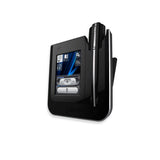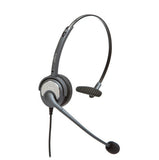 |
 |
 |
How to Choose the right wireless headset
If you use your telephone for extended periods or type simultaneously when speaking on the phone, then you should invest in a headset. By using a headset you will help to reduce arm and shoulder muscle tension and allow you to type freely when on the phone, thus increasing productivity by up to 43%. Wireless headsets can also benefit you in that they ensure freedom and multitasking when on the phone. This buyer's guide will help you to understand the important factors when choosing a headset:
Choosing the Right Headset
To choose the correct headset for your requirements, please follow these four easy steps:
1. Compatibility – Check the manufacturer and model name and number of your telephone that requires the headset, and if it has a headset port on the telephone (either located on the side, back, or underneath the telephone). Most new telephone systems have a dedicated headset port on the telephone. With this port you can directly connect the headset to the telephone without the use of an amplifier. For telephones without a headset port, you will need to purchase an amplifier to fit the headset you will purchase, and be the same brand. Also check to see if the headset you choose requires an extra cord to connect to either the handset or the amplifier.
2. Voice Tube or Noise Cancelling – Noise cancelling microphones suppress 70% of background noise so the person on the other end of the call does not hear as much background noise. This is especially useful in call centre or open plan environments, or where noise is a constant issue. In spaces where noise is not an issue, a voice tube can be used.
3. Corded or Wireless Headset? – Wireless headsets allow roaming while on the phone and increase productivity as you are free to multitask. Wireless headsets also reduce the amount of wires on your desk, and with a handset lifter, you can even answer a phone call while away from your desk. DECT headsets offer a range of up to 100 metres.
4. Style; Monaural, Binaural, or Convertible? – Wireless headsets are convertible and come with both a headband and earpiece. For a corded headset there is a choice of Monaural, Binaural, Over the ear only, or Convertible. In most cases a monaural (one ear style) headset is chosen as it allows the user to be on the phone as well as consult with colleagues, or hearing the environment around them. Binaural uses both ears to hear the calls and is used for when a user is finding it difficult to hear the phone conversation, or when greater concentration is required.
Ergonomics of Headsets
In today's working environment, office workers tend to spend anywhere from 25 to 40 hours a week in a static position while working on computers. A study by the University of Surrey (full study below) showed 50% of participants suffered from neck pain. They also found that using a telephone headset reduced headaches by 27%. The study that Plantronics undertook (link below) found that headset users experienced 35% less muscle tension than handset users.
Productivity
Plantronics also found in their study that headsets increase workplace efficiency and productivity by as much as 43%. Headset users also found their call response time was up by 72% and had an increase in typing speeds of up to 43%. With this information in mind, there is no argument that using headsets will be beneficial for you in terms of productivity and health.